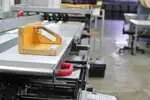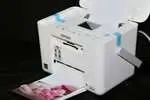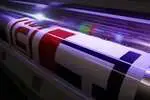Wondering for a long time how fashion designers get those prints on various fabrics, this is the guide for you to read. Here we will discuss what is all-over sublimation printing, its pros/cons, why and how it is used, and what materials you should use for it.
It is popular because you can get various styles and you will get a full print all over the shirt, hence called all-over sublimation printing. This printing method provides you with the power of customization and personalization to the core.
And it is way better than screen printing. We are going to discuss all these aspects of all-over sublimation printing, so keep reading.
What Is Sublimation Printing?

We all know and understand the various printing techniques to get a design printed on one section of the fabric or any other material. However, this is something different when we talk about all-over sublimation printing.
With this kind of sublimation printing, you can get the design all over the fabric. This design will go through those seams, zips, and hems. So, this type of printing makes sure the materials are entirely covered with the print.
With these techniques, you can create various designs on polyester shirts, socks, leggings, hoodies, and other clothing types. The only thing you will have to consider here is the right type of fabric material.
Of course, you will have to heat-press the design before it goes on the fabric. Therefore, you need to complete the printing process onto the fabric before it goes for sewing. That is how the print goes under the seam, zips, and hems.
You can use this printing technique for your work team and your social media campaigns or use it for yourself. The primary benefit of all-over sublimation printing is that you will have a continuous design at your hand, not just a small patch printed on one area of your polyester shirt.
This way of sublimation printing is the latest trend in fashion, and you will have to follow various precautions with your printer, which will render a flawless print without any white dots. You can achieve this all-over print with various methods, but here we will only focus on the dye sublimation techniques since it is the most popular of them all.
What’s The Dye Sublimation Process?

It’s a printing technique involving a heat press that allows you to use heat onto the transfer paper using a printed version of the design you are looking to print.
The ink is then sublimated into the fabric in its gaseous form to achieve the best resolutions with various colors from this transfer paper.
Why is this technique so popular? Well, you can use a variety of fabrics for this and can also use non-fabric materials. You can use this technique in printing your designs on glass, plastic, fiberglass, and aluminum.
In addition, you can do printing on those woven polyester fabrics, home decoration items, and signages. You can use ceramic tiles and even use photographic images as your designs for printing.
But to make it all work, you will need to have some tools at your hand. You will need a sublimation printer for this and sublimation paper as well. There is no other paper that can work here with this sublimation machine.
In addition, you will need a computer and an image processing software program. You’ll need a heat press and a cutting device , including printing materials and heat-resistant gloves and tape.
Where To Begin With?
If you decide to make high-resolution custom materials, this section will cover everything you need to start working on your DIY sublimation printing projects. Here, we will discuss all the equipment you need to get up and running with sublimation printing.
Sublimation printer

This printer is what you will need to print all your materials. There are various printer options available for both experts and newbies in the field of sublimation. These machines will enable you to transfer your design in high-quality on the transfer paper, and you will be able to use this to create your materials.
You need to keep one thing in mind that these printers work with applications involving dye-sub. It means you can only use the ink for dye sublimation and not other types. These applications can be wide from 10 inches to 44 inches, and you can choose based on your budget and work volume that you want to engage in.
A design software program and a computer
Before even thinking about printing, you will have to develop a design that you want to print. And for that, you will use your computer and a software program that deals in graphic design.
Any software program such as Adobe Photoshop, Illustrator, Sawgrass, Corel Draw can work here. You can use these programs to create different designs that you will use in your printing process.
The best part is that you don’t even have to be that tremendous graphic designing to get those fantastic designs. So, the only thing you will have to do is research and try a few different things. We will have a brief discussion on this in a bit.
Mug/heat press
You will require a mug press if you are going to print different drinkware. And if you are looking to print fabrics, you’ll need to go for a heat press. Make sure to use it on transfer paper first to get those high-resolution and vibrant prints and then print them on the materials.
There are various features that you need to consider to choose a heat press. But the most important one of them all is the platen size. It is the surface where you will place your products.
The bigger on this surface is, the bigger products you will be able to work with. Also, consider buying that mug oven if you are looking to use a mug press. It will come in handy if you are going to print many mugs simultaneously.
Sublimation blanks
This is the blank version of the things that you want to customize. But you must keep in mind that products containing polyester-like fabrics or products coated with polyester like those mugs can be sublimated. So, this is the only stuff you can use if you are looking for those exceptional quality designs.
Sublimation ink
There are different types of sublimation inks available. They are known as disperse dyes. You can also call them dye-sub inks. These inks can sublimate at very high temperatures and can easily print on polyester or polyester-coated surfaces.
Therefore, these prints become permanent and easily washable. In addition, there are various vibrant colors available, and some of them are even fluorescent.
Sublimation paper
This paper is used explicitly for sublimation printing as it can hold the inks that you will use for heat transfer onto your required surfaces. Thus, you can heat transfer the design onto the surface of the materials you want to print from the sublimation paper.
Heat resistant gloves and tape
As you are going to deal with high temperatures, therefore, you will need some heat protection. So, heat-resistant gloves and tape will come in handy here. The gloves will allow you to handle those hot objects without getting any burns.
While the heat-resistant tape will allow you to fasten your sublimation paper to the blank as you are using your heat press. You don’t want your materials to shift under the media as it will ruin the design. So, you will need this tape to keep those materials in place.
Software Programs Useful for Sublimation Printing

Whether you are new to designing or a professional, a designing software program is just right for you.
Adobe Photoshop & Illustrator
On this platform, you can create a variety of design templates whenever you process a type. You can be very creative here and use a different range of attractive patterns. You can continue to repeat them throughout your designs.
Designs have used this program at all levels for a very long time. Therefore, you can use a variety of resources on the internet and keep on learning new things. But to use this program, you will have to subscribe to a paid plan.
Like Photoshop, Illustrator is integrated into Adobe’s Suit, and it has been frequently used by designers and comes with a paid subscription.
Corel Draw
If you are tight on budget, you can use Corel Draw as well. You can download this program and can use it for free. This program allows you to create high-quality graphics and images and access a range of different image effects.
There are various features available here that are also available in Adobe Illustrator, so it’s a good alternative. Moreover, this program deals in vector graphics so that you will have design freedom as well.
Sawgrass Creative Studio
This program came into being primarily for sublimation printing. Once you purchase any sublimation system by Sawgrass, the program will go with it for free.
There are different sublimation patterns available that are custom made, and you will only have to tweak them according to your creative needs. In addition, this is a web-based platform, so you can access it from multiple devices.
There is a free and paid package available for this program, and you will be able to access a plethora of designs that are ready to print and come with an array of themes.
Printers Used for This Printing
The printers that are used for all-over sublimation printing are large or wide format printers. These units can produce print rolls with widths ranging between 18 to 100 inches. Therefore, you can print on a large scale and can maintain the high quality of the design. Some of the best wide-scale printers available on the market are:
Sawgrass VJ628 Virtuoso
This is the first of its kind fully integrated sublimation printer to work with desktop computers. It is 25-inch in size and has eight different colored inks.
You can conveniently use it to print 24-inch products in 1400×1400 dpi. With this printer, you will also get access to Sawgrass Print Manager and 8 inks and online designing programs that we just talked about earlier.
HP Epson T630 DesignJet
This is the smallest wide format printer available on the market, and it can print 36-inch wide rolls and up to 36 x 74.7-inch sheets. In addition, it can render a design with the exact line for the pros who are looking to print maps and other technical drawings along with posters.
It has a modern look, and it will be the right fit for your home and office. An inbuilt stand is there, and its compact construction is a space saver.
Epson Surecolor
This is another handy wide format printer that professionals in sublimation printing frequently use. The max printable cut on rolls and sheets available with this printer is 24-inch in size, and the resolutions we are talking about here are 2880×1440 dpi.
What Is the Best Wide Format Heat Presses Available?

Like the wide-format printers, wide format heat presses are mandatory for those heat transfers on large-sized garments. There are different platen sizes available here, and they also come with high-pressure lifting mechanisms. The best ones to consider are:
Heat Press Nation Blue Series
This is one of the best heat presses available on the market. It ensures a full end-to-end even pressure and heating. In addition, it comes with a non-coated heat platen that is 15 x 15 inches and comes with heating coils to ensure quick heating.
Heat Press Nation CraftPro
Here’s another one by Heat Press Nation, and it is available in 15 x 15 inches and 13 x 9 inches. It also comes with a lower slide-out plate that allows you to work away from the heat. There is a digital temperature display, and it will provide you with the heat value when your work is done. It also features an auto-start timer and a digital timer as well.
How Does It Work?
Here are three significant steps that are involved in the entire all-over sublimation printing process.
Creating the design
You need to turn your computer on and go to your designing software program. Your design program might have different templates available based on which program you are using. Or you can create your design from scratch.
Printing your design out
Now you need to take a printout of your design using the sublimation printer. You have to load a sublimation paper into your printer, load the cartridges with different colors, and transfer the design to the sublimation paper. You will have to wait for the design to come out entirely rendered.
Transferring onto the substrate
After fully satisfied with the design and coming out, transfer it to the printed paper using your heat press. You need to place the fabric on its platen and then apply. Heat is applied to the paper on top of the fabric, where the ink will seep through every fiber.
Pros & Cons of This Printing
There are numerous benefits of using all-over sublimation printing, but there are a few cons, and you need to keep them in mind before you get going with this printing technique.
Pros
With sublimation printing, you can create a variety of unique designs. These designs come out on the materials in a similar fashion they appeared on your computer. If you have a brand that you want to imprint, this method will be very useful for you as you can print your logos on a different event and conference materials.
As you heat process the design onto your material, that ink is entirely washable and permanent. Any other printing technique will only stamp the design onto the cloth, and it remains open to wearing over time. But all over sublimation printing eradicates this for good and makes the design impossible to get dull or wash away over time.
Cons
The initial cost to begin working with all-over sublimation printing is pretty expensive. You will need special heat presses, printers, designing software and ink. However, sublimation paper doesn’t come cheap. The cost gets going from a few thousand dollars and up pretty fast, and then there are materials purchase costs as well.
Not the best option for bulk orders
Dye sublimation is costly and is time-consuming as well. Therefore, it works better with small projects that involve only a dozen shirts and 2 or 3 other materials. However, it is not a good option for bulk orders where you will need speed and fast printout times.
You are strictly limited to polyester and polyester-coated materials and nothing else. This is because the high-resolution images with vivid colors are only going to come out on these surfaces. In addition to that, you cannot use dark-colored surfaces for this princess as well. You have to go for light-colored surfaces, preferably white.
Design Tips for This Printing
Here are some tips that you need to follow when working on your all-over sublimation printing projects.
- Make sure to go with the designs that are not going to make those creases more noticeable. Therefore, it is best to go for pattern prints with a very busy design or a white background.
- Don’t forget to use continuous designs that spread across the entire t-shirt. These t-shirts are just like your step & repeat banners, and the artwork needs to expand all over the products.
- Make sure to check the sample before you start with your all-over sublimation printing job. So, try out one t-shirt first and see for any flaws. Then, rectify them and begin with the job.
- You also need to consider how your design will look in different T-shirts if you are ordering different sizes.
- Make sure to keep your branding consistent for a more professional look.
Design Do’s and Don’ts for DIY All Over Sublimation Printing Projects
What designs work?
This type of printing will work very well for your DIY projects if you go for those ridiculous and quirky designs. That’s exactly why this type of printing works well with dramatic printouts.
Such designs have become a hot trend in recent years, and you will see them in both low and high-end stores. You can cover the entire t-shirt with your design and can also use vibrant colors.
In addition, you can also go for repeated designs in your DIY projects while keeping the full coverage if the t-shirt is in your mind. Finally, you can go for pattern printing and try out different patterns in vibrant colors.
Moreover, you can use photography prints as your designs in your DIY printing project. You can fill the entire garment with the photograph and don’t have to place it just on the front of the garment.
You can go with image printing in a rectangular fashion and also use a landscape design to print on your t-shirt by using it in different angles. This printing technique works for printing logos as well.
What designs won’t work?
You can’t use designs that block colors or the designs that need exact placement in your DIY all-over sublimation printing projects. However, if you have designs that have some slogans or direct-to-garment printing, they will work much better with this technique.
If you are only going for a logo in your DIY project right in the center of your garment, all-over sublimation printing might not be the right option as it can turn out to be pretty expensive. For this process, you need to go for DTG printing.
Is All Over Screen Printing Better/Worse than All Over Sublimation Printing?
There is another option that is frequently used, and that is all over screen printing. This option comes in handy to tackle the bulk order limitations that all over screen printing has. But it limits you in terms of design options and colors.
What is screen printing?
Screen printing is the old-school way of all overprints. These printing techniques can work with many applications, but it does come with some barriers as well.
This type of printing uses a screen to capture design onto your garment. Each color is separated into different layers during the preparation of a design, and a screen is created for each of these corresponding colors.
Therefore, a design that has 6 colors in it needs 6 different screens. After that, all the colors are printed with each layer, and this is a pretty time-consuming process. But most of the work is associated with the initial step because there is plenty of time to create each layer’s screens.
Therefore, most designs are limited to 6 colors, but they max out between one and three. Hence, screen printing is an ideal option for simple designs. But once these screens are created, you can easily tackle bulk orders.
Screen printing advantages
Screen printing is pretty flexible, and no other printing methods come even close. You can use it on all surfaces as long as they are flat.
There is plenty of versatility when you are looking to print on a piece of fabric. If you plan to go with the same designs, screen printing is your preferred option as it will be more cost-effective. As you print more with this technique, you will reduce your printing cost.
This princess is best for simpler designs that don’t feature many colors or have too many details. Therefore, you can use this method to print logos, graphics, and names.
However, it will not work very well if you use it for photography or other imaging with intricate details. But you can go for gradients with this technique, and the design is durable as well.
Screen printing disadvantages
The biggest setback that you have to deal with here is the huge production cost. If you are going for limited or low quantities, then you are paying too much per print. On average, you should at least need to go for 150 pieces to print with this technique to remain cost-effective.
Apart from that, screen printing is pretty time-consuming when it comes to setup. And it can significantly lengthen the overall turnaround. In addition, you can’t go for too many design details and color variations as well.
FAQs
Can I use black or dark-colored fabric for all-over sublimation printing?
No, you cannot use black or dark-colored fabric for all-over sublimation printing. The design and vibrant color will not be prominent, and the result will be a flat and missing portion of printouts. But you can use dark colors or black if you are only using white or light-colored designs and images, but it’s better to try out a few samples before you get to the job.
Can I use materials other than polyester for all-over sublimation printing?
No, your material options are pretty much limited to polyester or polyester coating materials, and that’s it. You can also use a blend of cotton and polyester, but the prints will be dull to some extent. However, you can use polyester-coated materials and fabrics for all-over sublimation printing.
Are the prints that come from all over sublimation printing durable or not?
The prints that are heat pressed into the fabric using all-over sublimation printing are extremely durable, and you can wash them. You won’t have to deal with any dullness over time, and the prints won’t crack or peel away either.
Conclusion
All-over sublimation printing is a good option to try out if you want to start your own small printing business. Of course, you will need to have the right tools to begin with, your printing jobs, but once everything is set up, you can conveniently handle all orders on your own.
The designing software programs will allow you to create different designs in vivid colors. You can get the transfers using a quality heat press after getting the printouts from a sublimation printer. But prepare yourself for a hefty cost upfront for setting it all up.

